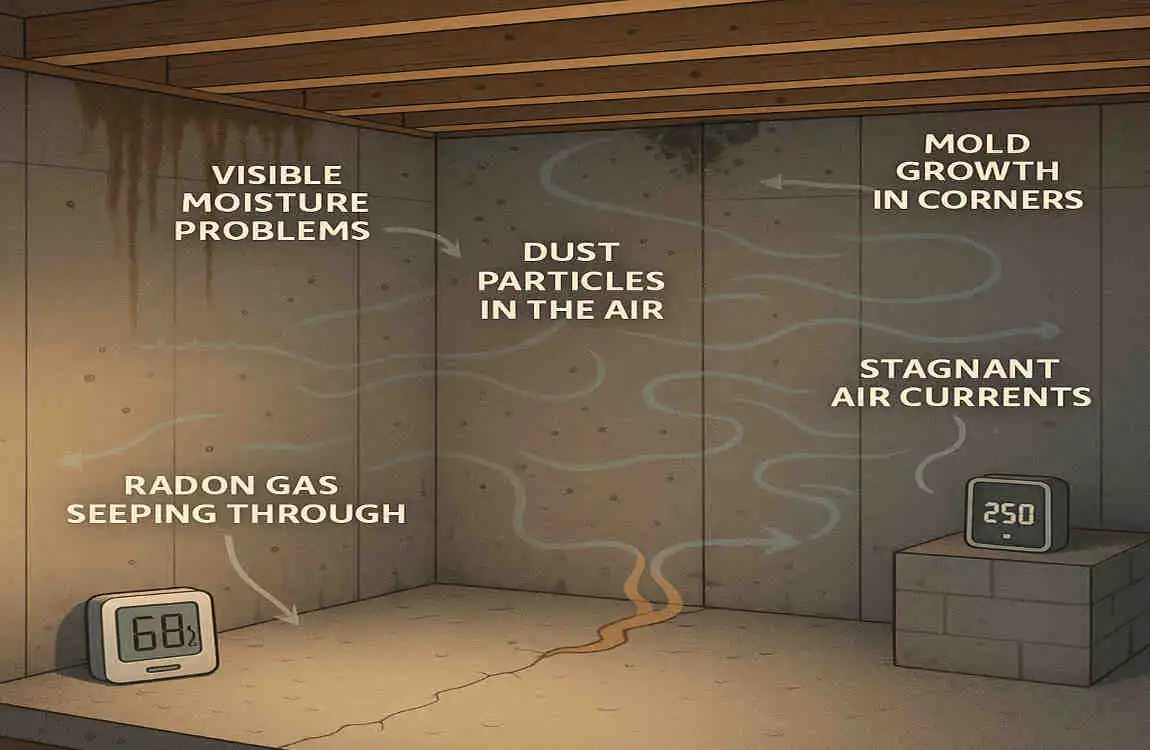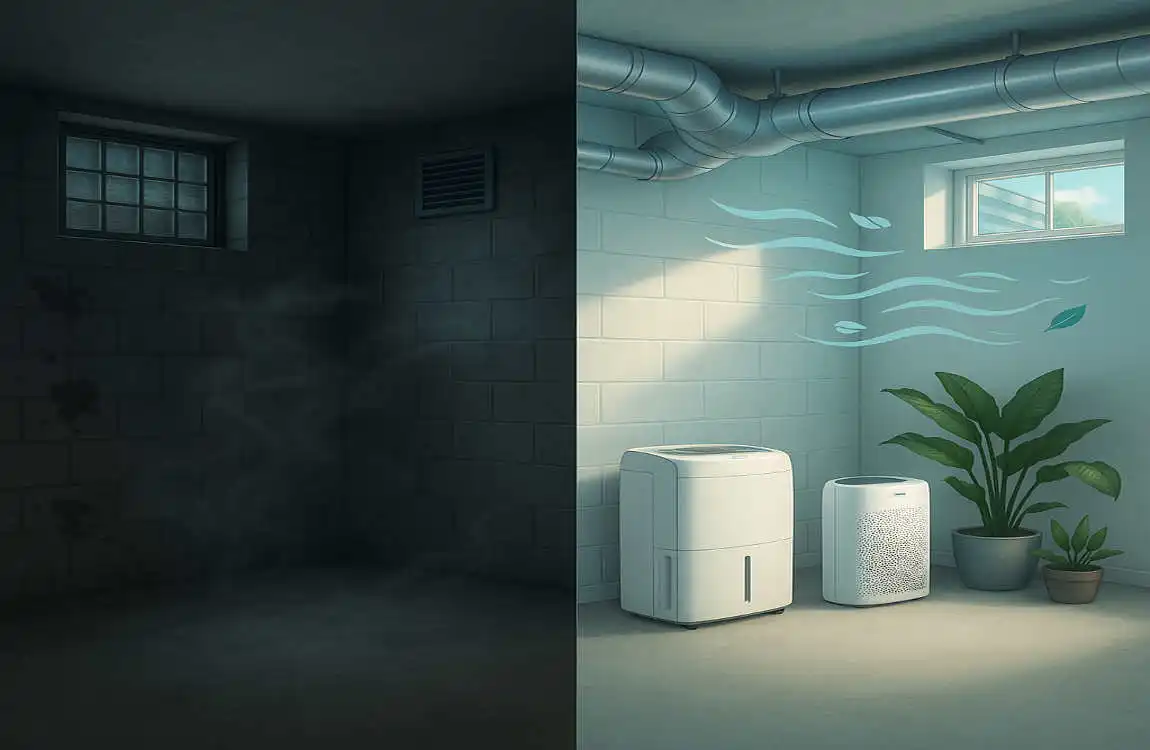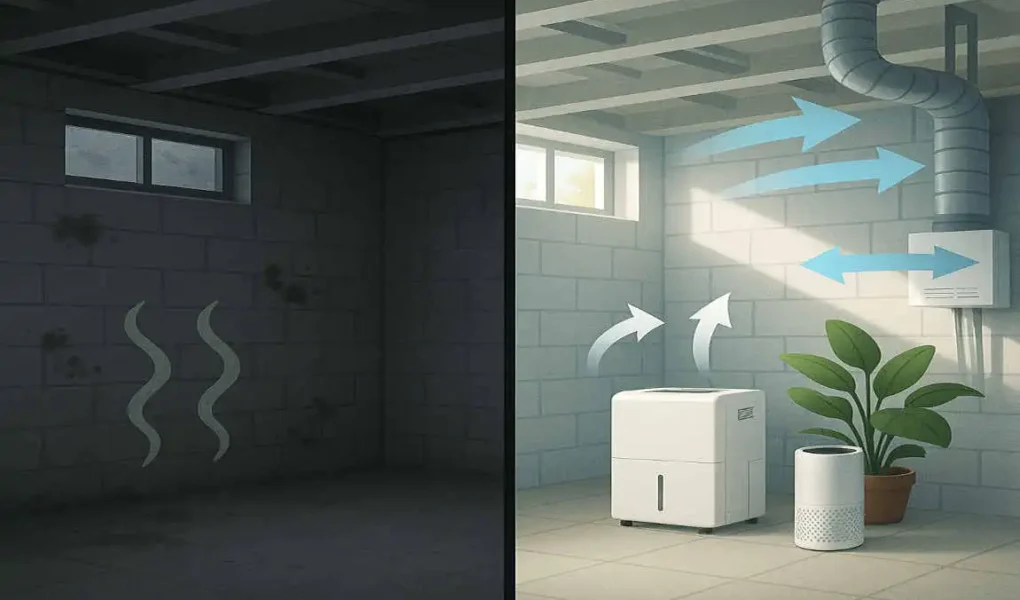Are you worried about the air quality in your basement? You’re not alone. Many homeowners struggle with dampness, mold, musty odors, and other pollutants in their basements. But did you know that improving your basement air quality is crucial for the overall health of your home?
Understanding Basement Air Quality Issues

Before we delve into the solutions, let’s take a closer look at what basement air quality truly means and why it’s so crucial.
What Comprises Basement Air Quality?
Basement air quality is influenced by a variety of factors, including:
- Humidity: High humidity levels can lead to mold growth and musty odors.
- Airborne Particles: Dust, pollen, and other allergens can circulate in the air.
- Mold Spores: Mold can grow in damp basements and release spores into the air.
- Radon: This naturally occurring radioactive gas can seep into basements from the ground.
- Volatile Organic Compounds (VOCs): These chemicals can be released from paints, adhesives, and other building materials.
Causes of Poor Basement Air Quality
Several factors can contribute to poor basement air quality, such as:
- Moisture Intrusion: Water leaks or high humidity can create a breeding ground for mold and mildew.
- Poor Ventilation: Without proper airflow, pollutants can become trapped in the basement, posing a health risk.
- Lack of Temperature Control: Temperature fluctuations can lead to condensation and moisture buildup.
Health Risks of Poor Basement Air Quality
Breathing in poor-quality air in your basement can have serious health consequences, including:
- Allergies: Mold, dust, and other allergens can trigger allergic reactions.
- Respiratory Issues: Poor air quality can exacerbate asthma and other respiratory conditions.
- Mold-Related Illnesses: Prolonged mold exposure can lead to a range of health problems.
Signs Your Basement Air Quality Needs Improvement
If you notice any of the following signs, it may be time to take action to improve your basement air quality:
- Musty Smell: A persistent musty odor is a telltale sign of mold or mildew.
- Visible Mold: If you can see mold growth on walls, floors, or ceilings, your basement air quality is likely suffering.
- Condensation: Water droplets on windows or pipes indicate high humidity levels.
Key Factors Affecting Basement Air Quality
Now that we understand the basics of basement air quality, let’s explore the key factors that can impact the air you breathe in your basement.
Moisture and Humidity Levels
High moisture and humidity levels are among the primary culprits contributing to poor basement air quality. When the air in your basement is excessively damp, it creates an ideal environment for mold and mildew to thrive.
Ventilation and Airflow
Proper ventilation is essential for maintaining good air quality in your basement. Without adequate airflow, pollutants can become trapped, leading to a buildup of harmful substances in the air.
Presence of Mold and Mildew
Mold and mildew are common problems in basements, especially in damp environments. These fungi can release spores into the air, triggering allergic reactions and respiratory issues.
Airborne Contaminants
In addition to mold and mildew, your basement air may contain other airborne contaminants, such as dust, radon, and volatile organic compounds (VOCs). These pollutants can originate from various sources, including building materials, cleaning products, and outdoor air.
Construction Materials and Finishes
The materials used to construct and finish your basement can also impact air quality. Certain materials, such as carpeting and specific types of insulation, can trap moisture and promote the growth of mold.
How to Improve Basement Air Quality: Essential Home Tips

Now that we’ve covered the basics, let’s explore some practical tips for enhancing your basement air quality and creating a healthier living environment.
Moisture Control Strategies
Controlling moisture is key to improving basement air quality. Here are some strategies to help you keep your basement dry:
Inspect and Repair Foundation Cracks and Leaks
The first step in moisture control is to identify and repair any cracks or leaks in your basement’s foundation. These can be entry points for water, leading to dampness and mold growth.
Use Dehumidifiers to Maintain Optimal Humidity
Investing in a good-quality dehumidifier can help you maintain optimal humidity levels in your basement. Aim for a relative humidity of 30-50% to discourage mold growth.
Proper Drainage Solutions Outside
Ensuring proper drainage around your home’s exterior can also help keep your basement dry. Ensure your gutters and downspouts direct water away from your foundation, and that the ground slopes away from your home.
Waterproofing Basement Walls and Floors
Applying a waterproof coating to your basement walls and floors can provide an extra layer of protection against moisture intrusion. This can be especially helpful in areas prone to flooding or high water tables.
Enhancing Ventilation
Improving ventilation is another crucial step in maintaining good air quality in the basement. Here are some ways to enhance airflow in your basement:
Install or Upgrade Basement Ventilation Systems
If your basement doesn’t have a dedicated ventilation system, consider installing one. These systems can help circulate fresh air and remove pollutants from your basement.
Use Exhaust Fans or Air Exchangers
Exhaust fans and air exchangers can also help improve ventilation in your basement. These devices work by removing stale air and bringing in fresh air from outside.
Strategically Open Windows and Vents
When the weather permits, opening windows and vents can be a simple and effective way to improve ventilation in your basement. Just be sure to close them when humidity levels are high to prevent moisture buildup.
Consider Mechanical Ventilation for Sealed Basements
If your basement is sealed tightly for energy efficiency, you may need to consider mechanical ventilation to ensure adequate airflow. These systems can be especially helpful in newer, more airtight homes.
Mold and Mildew Prevention
Preventing mold and mildew growth is essential for maintaining good basement air quality. Here are some tips to help you keep these fungi at bay:
Regularly Inspect for Mold Growth
Keep an eye out for any signs of mold growth in your basement, such as black or green spots on walls, floors, or ceilings. Catching mold early can help prevent it from spreading and impacting air quality.
Clean and Remove Visible Mold
If you do spot mold in your basement, it’s important to clean and remove it promptly. Use a solution of water and detergent, or a specialized mold cleaner, to scrub away visible mold. Be sure to wear gloves and a mask to protect yourself from spores.
Use Mold-Resistant Paints and Sealants
Applying mold-resistant paints and sealants to your basement walls and floors can help prevent mold growth. These products contain special additives that inhibit the growth of mold and mildew.
Maintain Low Humidity to Discourage Mold
As we mentioned earlier, maintaining low humidity levels is key to preventing mold growth. Use a dehumidifier and monitor your basement’s relative humidity to ensure it remains within the safe range of 30-50%.
Air Purification and Filtration
In addition to controlling moisture and improving ventilation, using air purifiers and filters can help remove pollutants from the air in your basement. Here are some options to consider:
Use Air Purifiers Equipped with HEPA Filters
HEPA (High-Efficiency Particulate Air) filters are designed to capture tiny particles, such as dust, pollen, and mold spores. Using an air purifier equipped with a HEPA filter can help improve the air quality in your basement and reduce allergens.
Clean and Change HVAC Filters Regularly
If your basement is served by a central HVAC system, be sure to clean house basement and change the filters regularly. Dirty filters can circulate pollutants back into your basement air, so it’s important to keep them clean.
Consider Activated Carbon Filters to Reduce Odors and VOCs
Activated carbon filters can help remove odors and volatile organic compounds (VOCs) from the air in your basement. These filters work by adsorbing these substances onto their surface, trapping them, and preventing them from circulating.
Radon Testing and Mitigation
Radon is a naturally occurring radioactive gas that can seep into basements from the ground. Exposure to high levels of radon can increase your risk of lung cancer, so it’s important to test for it and take action if necessary.
Explain the Health Risks of Radon Gas
Radon is the second leading cause of lung cancer after smoking, and it’s responsible for an estimated 21,000 lung cancer deaths each year in the United States alone. Because radon is odorless and invisible, the only way to know if you have a problem is to test for it.
How to Test for Radon in the Basement
Testing for radon is easy and affordable. You can purchase a radon test kit at most hardware stores or hire a professional to do the testing for you. Place the test kit in your basement for the recommended amount of time (usually 2-7 days), then send it to a lab for analysis.
Options for Radon Mitigation if Levels are High
If your radon levels come back high (above 4 pCi/L), you’ll need to take action to mitigate the problem. The most common solution is to install a radon mitigation system, which works by drawing radon gas from beneath your home and venting it outside. A professional can help you choose the right system for your home and install it properly.
Proper Basement Finishing Materials
Choosing the right materials for your basement can also help improve air quality. Here are some tips for selecting moisture-resistant and mold-resistant products:
Use Moisture-Resistant Drywall, Flooring, and Insulation
When finishing your basement, opt for moisture-resistant materials, such as green board drywall, vinyl or tile flooring, and closed-cell spray foam insulation. These products are designed to withstand damp conditions and resist mold growth.
Avoid Carpeting or Materials Prone to Mold
Carpeting can trap moisture and encourage mold growth, so it’s best to avoid it in basements. If you must have carpet, choose a mold-resistant variety and ensure it remains clean and dry to prevent mold growth. Similarly, avoid using wood or other organic materials that can be damaged by moisture and mold.
Routine Maintenance Tips to Sustain Air Quality
Improving your basement air quality is just the first step. To keep your basement healthy and comfortable, regular maintenance is essential. Here are some tips to help you stay on top of things:
- Regularly Inspect for Leaks and Moisture Buildup: Keep an eye out for any signs of water intrusion or dampness in your basement. Catching problems early can help prevent them from escalating.
- Schedule Seasonal HVAC and Air Quality System Maintenance: Have your HVAC system and any air purifiers or dehumidifiers serviced regularly to ensure they’re working properly and not circulating pollutants.
- Keep Basement Clean and Clutter-Free: A clean, clutter-free basement is less likely to harbor dust, mold, and other pollutants. Make it a habit to tidy up regularly and keep surfaces clear.
- Monitor Humidity Levels with Hygrometers: Use a hygrometer to keep track of your basement’s relative humidity. If it starts to creep above 50%, take action to reduce moisture levels.
- Periodically Retest for Radon and Other Pollutants: Even if your initial radon test came back low, it’s a good idea to retest every few years to ensure levels haven’t changed. You may also want to test for other pollutants, such as VOCs or mold spores.
Benefits of Improving Basement Air Quality
Improving your basement air quality has a range of benefits for your home and your family’s health. Here are just a few reasons to take action:
- Enhanced Family Health and Reduced Allergy/Respiratory Issues: By reducing allergens and pollutants in your basement air, you can help alleviate allergy and respiratory symptoms, promoting overall health.
- Increased Comfort and Usable Living Space in Basement: A dry, well-ventilated basement is a more comfortable place to spend time. By improving air quality, you can make your basement a more usable and enjoyable part of your home.
- Protection of Home Structure from Mold and Moisture Damage: Mold and moisture can cause serious damage to your home’s structure over time. By controlling these factors, you can help protect your investment and avoid costly repairs.
- Improved Indoor Air Quality Overall in the House: Because air circulates throughout your home, improving basement air quality can have a positive impact on the air you breathe everywhere. A healthier basement means a healthier home overall.




